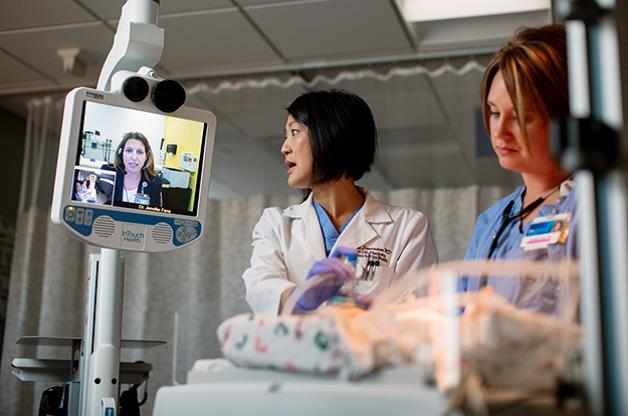-
Featured News
Emergency video telemedicine positively impacts newborn resuscitation
 ROCHESTER, Minn. — Approximately 10 percent of newborns require help breathing after birth, and 1 in 1,000 newborns require more intensive resuscitation measures. These infrequent, high-risk deliveries may present challenges to community hospitals less familiar with advanced newborn resuscitation interventions. Telemedicine consultations are a good option to help meet these challenges and positively impact patient care, according to a study published in Mayo Clinic Proceedings.
ROCHESTER, Minn. — Approximately 10 percent of newborns require help breathing after birth, and 1 in 1,000 newborns require more intensive resuscitation measures. These infrequent, high-risk deliveries may present challenges to community hospitals less familiar with advanced newborn resuscitation interventions. Telemedicine consultations are a good option to help meet these challenges and positively impact patient care, according to a study published in Mayo Clinic Proceedings.
“Following a complicated delivery, a newborn’s outcome is associated with the quality of care provided during the first minutes of life,” says Jennifer Fang, M.D., a Mayo Clinic fellow in Neonatal-Perinatal Medicine and one of the study’s authors. “Because of this reason, it is critical to understand how telemedicine can be used to positively impact those outcomes.”
During a 20-month study, Mayo Clinic’s Division of Neonatal Medicine worked with six health system sites to provide newborn telemedicine consultations. During the study, 84 telemedicine consultations were conducted.
“The enhanced access to neonatologists, who could remotely assess the newborn and guide the local care team through the resuscitation, allowed one-third of the babies to stay with their families in the local hospital,” says Dr. Fang. “This allowed the patients to receive the correct level of care in the right location — increasing the value of care. Also, the potential cost savings can be substantial.”
This study also looked at how the local care team and neonatologist collaborated. “Other research has shown that teamwork and communication are critical during neonatal emergencies. We wanted to assess how telemedicine affected teamwork and communication,” according to Dr. Fang.
MEDIA CONTACT: Carol Berteotti, Mayo Clinic Public Affairs, 507-284-5005, newsbureau@mayo.edu
Providers responded positively to surveys that assessed teamwork and the impact of the telemedicine consult on patient safety and quality of care. “These results speak to the acceptability and clinical impact of this type of telemedicine project in community hospitals,” says Dr. Fang.
In addition to Dr. Fang, the paper’s co-authors are:
• Christopher Collura, M.D., Mayo Clinic
• Robert V. Johnson, M.D., Mayo Clinic
• Garth Asay, M.D., Mayo Clinic
• William Carey, M.D., Mayo Clinic
• Douglas Derleth, M.D., Mayo Clinic
• Tara Lang, M.D., Gundersen Health System
• Beth Kreofsky, Mayo Clinic
• Christopher Colby, M.D., Mayo Clinic
###
About Mayo Clinic Proceedings
Mayo Clinic Proceedings is a monthly peer-reviewed medical journal that publishes original articles and reviews dealing with clinical and laboratory medicine, clinical research, basic science research and clinical epidemiology. Mayo Clinic Proceedings is sponsored by the Mayo Foundation for Medical Education and Research as part of its commitment to physician education. It publishes submissions from authors worldwide. The journal has been published for more than 80 years and has a circulation of 130,000. Articles are available at mayoclinicproceedings.org.
About Mayo Clinic
Mayo Clinic is a nonprofit organization committed to clinical practice, education and research, providing expert, whole-person care to everyone who needs healing. For more information, visit http://www.mayoclinic.org/about-mayo-clinic or https://newsnetwork.mayoclinic.org/.







